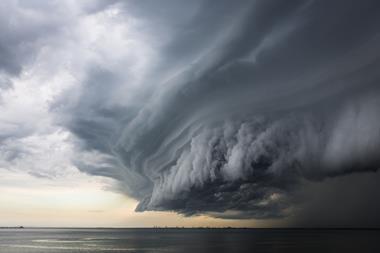According to studies by the Institute for Business & Home Safety, a Florida based research group, 25% of all companies that shut down due to disaster never reopen. For small businesses, the figure can be as high as 50%.
Even though the 2006 hurricane season was relatively uneventful, business owners in coastal regions continue to need adequate contingency plans to ensure their businesses reopen as quickly as possible if disaster strikes. Studies indicate that businesses with effective plans can significantly reduce direct and indirect property damage and recover faster. Simply put, contingency planning is an investment in the survival and future of a business.
Pre-hurricane planning
A hurricane emergency plan is designed to achieve three main goals: ensure the safety and well-being of employees and others, mitigate property and equipment damage, and minimise the time it takes to get the business back in operation.
Perhaps the plan's most essential component is the creation of an emergency response team (ERT). ERT members should be trained in all aspects of the emergency action plan, including liaison with local emergency services. The team should have people with decision-making authority and also people who have knowledge of how the facility operates, including security personnel if needed.
The business should then develop a plan for communicating with employees in the days and weeks after a storm, so that they can receive updates about the business, have access to payroll and benefits information, and learn estimated dates for returning to work. The business should do this well in advance of a hurricane and communicate to employees consistently and frequently.
Many companies with locations in storm prone areas ask employees for alternative contact information, such as the phone number of an out-of-state relative or a personal email address, so that they can verify employee safety after the event and contact workers who can assist in the business recovery process.
Another critical element of a hurricane emergency plan is an ERT supply kit that includes items such as two-way radios, portable radios, flashlights, lanterns, batteries, rubber boots, gloves, blankets or sleeping bags, first-aid kit, extra clothing and at least a 72 hour supply of non-perishable food and water to feed the team.
Making preparations
Businesses should develop and regularly test procedures to make sure they are properly prepared for shutdown. These should include:
- Creating a backup of computer system data.
- Removing any loose yard and roof debris.
- Establishing methods of safely shutting down operations and protecting key stock and equipment.
- Obtaining materials such as tarpaulins, cables, straps, wood and steel to anchor and brace exterior storage, cranes and roof mounted equipment.
- Obtaining an emergency generator to provide power for life safety systems and critical items such as coolers, freezers and communication equipment.
- Protecting building openings with storm shutters, pre-fitted plywood or other coverings to minimise damage from flying or floating debris.
- Identifying all hazardous and reactive materials and making provisions to store, neutralise or move them to a safe location.
- Developing pre-arranged plans with contractors and vendors for equipment and supplies.
When a hurricane is imminent
The business should deploy its hurricane emergency plan once the National Weather Services issues a hurricane warning - meaning that hurricane conditions are expected within 24 hours. The ERT should be put on alert, personnel should begin tracking the storm by broadcasts and the internet, and procedures should begin to shut down operations.
As the hurricane approaches, the business should also:
- Examine the property and repair any damaged covering, flashing, gutters or drains.
- Inspect the property for debris or equipment that could become dangerous projectiles during the storm.
- Ensure all emergency supplies are on site and equipment is operating properly.
- Make sure there is enough cash on hand for post-hurricane needs, such as buying food and emergency supplies for employees and contractors.
- Verify that fire protection and sprinkler systems are working.
- If possible, shut down any natural gas lines or electrical feeds to prevent fires or equipment damage. This may include an orderly shutdown of other hazardous processes and equipment.
After the hurricane
After the storm, it can be easy to assume the danger has passed. In reality, downed electrical lines or ruptured gas mains, unsafe structures and contaminated water are just a few of the hazards that exist once a storm has passed. The ERT team should follow safety measures at all times and adhere to the facility safety programmes before assessing the property or conducting any repairs. Contractors, like employees, should follow proper safety procedures at all times.
After getting permission to return from the local authorities, business owners should secure their site and begin assessing the situation. They should separate and document damaged material for insurance purposes, then prioritise repairs and begin work immediately.
Qualified individuals should examine all electrical systems, natural gas lines, fluid transfer operations, production and maintenance equipment, and building structures before returning them to service. Damaged fire protection systems should be quickly repaired and all potential ignition sources, such as smoking and work with heat producing tools, should be controlled.
Conclusion
A hurricane emergency plan is vital to the survival of businesses located in vulnerable areas. Once a plan is in place, it needs to be changed as the business changes. A plan has a shelf life, but unfortunately, it does not have an expiration date.
Businesses should conduct annual drills to test all aspects of the action plan, and to ensure that it reflects current conditions at the site. Business owners should request feedback from ERT members on the plan's effectiveness and identify areas for improvement.
An effective hurricane emergency plan will maximise business continuity. Planning the steps to take before, during or after a storm can make the difference between the survival or demise of a business.
- Ashutosh Riswadkar is line of business director, Zurich Services Corporation, Risk Engineering.
Email: ashutosh.riswadkar@zurichna.com
Website: www.zurichna.com


















